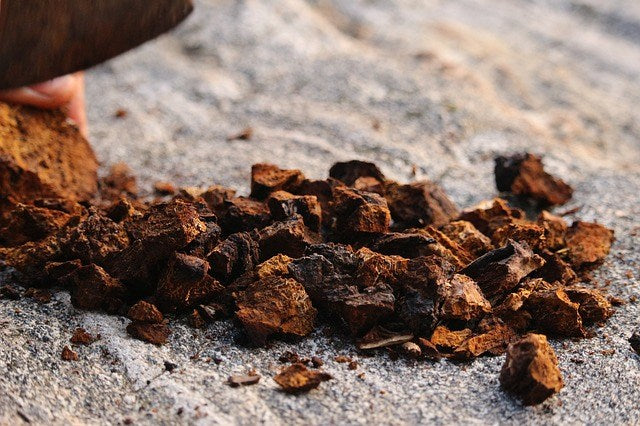What is a mushroom?
Mushrooms are often referred to as vegetables, but are neither animal nor vegetable in scientific terms. Mushrooms are structures produced by some types of fungus, and are similar to fruit on a plant. These fungi digest nutrients underground in a root-like network of mycelium, then grow mushrooms above the ground to release spores into the air. While plants use sunlight to photosynthesize, fungi use secreted enzymes to externally digest nutrients in the soil.
Mushrooms are truly strange and fascinating. They have been used for centuries for both cooking and medicine across the world. Modern science is just starting to rediscover surprising facts about their many health benefits. You will notice that the size, appearance, and taste of mushrooms varies widely. Most mushrooms used for cooking or tea have a savory, earthy flavor.

What is Chaga tea?
Chaga tea comes from the Chaga mushroom (inonotus obliquus) which is a type of slow growing, non-toxic fungus typically found on birch trees in cold climates. The exterior looks like burnt charcoal. This odd shaped mass found in forests may look like just another mushroom, but inside it is a super powerful source of nutrients and antioxidants.
Chaga is parasitic to the birch tree, slowly sapping its nutrients until the tree dies. It can take around 80 years for the tree to die and only then does the chaga release spores to find a new tree. Since the process is so slow and only affects wounded trees, chaga does not harm birch forests overall. In fact, some say chaga is at risk. Chaga only grows in the wild and cannot easily be farmed, so we recommend buying sustainably sourced products to prevent over-harvesting.

How is Chaga harvested?
Chaga should only be harvested from living trees and great care must be taken to ensure the tree is not damaged or the chaga is over harvested. The chaga is then dried and broken into chunks or ground into powder. It's a good idea to make sure you are buying from a reputable vendor. Many Chaga vendors will let you know where the Chaga comes from.
Where does the Chaga come from?
Chaga often comes from Northern regions where birch trees are plentiful. Russia, North America, Northern Japan and Northern China are the prime areas where Chaga can be found.
Is Chaga tea good for you?
Chaga is an adaptogen, which means it helps the body adapt to stress. It can tone the nervous system to keep us calm and level headed under pressure. Since modern life is plagued by chronic stress and anxiety, chaga is rising in popularity as a natural treatment. Chaga is also believed to benefit the immune system by increasing our white blood cell production so we can defend against pathogens. There is even research on chaga’s potential ability to aid in cancer treatment. Not to mention it is filled with the same healthy antioxidants in black tea, green tea, and other true teas - without the caffeine!
Chaga Tea Benefits
- Nervous system
- Immune system
- GI tract
- Cardiovascular system
- Endocrine system
- Possible Anti-tumor
By supporting the body and mind in these ways, adaptogens help us to cope with stress, stay healthy during the cold and flu season, fight cancer cells, and lift us out of the dark depths of depression and adrenal burnout.
ORAC Value of Chaga
ORAC (Or Oxygen Radical Absorbance Capacity) measures the free oxygen radicals that food or supplement can absorb in your body. Chaga contains some of the highest amounts, but it will vary depending on when/where is is grown among other things. Compare ORAC values here.
How to Make Chaga Tea
Chaga is hard as wood and is much too difficult for our body to digest as a food. The best way to get the nutrients out of chaga is to extract it in hot water. Alternatively, you can buy powders that are ‘pre-extracted’ so the nutrients can be absorbed. Simply mix with the desired beverage of choice. For medicinal use, chaga mushroom is extracted in alcohol or boiled in water. Like other herbal teas, letting the Chaga steep longer will extract more nutrients. It should be at least 7 minutes.

What does Chaga tea taste like?
Chaga mushrooms do not taste like a typical mushroom found in a grocery store. It has a somewhat earthy flavor with a slight bitterness. It also contains a naturally occurring form of vanillin, the same as what is found vanilla bean. You can drink chaga mushroom straight, but the flavor may not be appealing to most. But because it is so dense in nutrients and anti-oxidants, the chaga mushroom lends itself to be an ideal component when blended with other herbs and spices. Like cooking with mushrooms, the earthy flavor will complement many other ingredients like ginger, turmeric and honeybush.
Does Chaga Tea Have Caffeine?
Pure Chaga is naturally caffeine free, so it makes a great nighttime drink. You'll often find chaga included in blends, however, which can add caffeine to the brew.
How often should you drink Chaga tea?
Chaga tea can be safely consumed in moderate doses. Drinking it in a blend with other beneficial herbs will lower the overall dosage, but give you exposure to a variety of other healthy compounds. Some users will increase dosage especially if they are sick or have an on-going health issue. If you are drinking chaga for this purpose, make sure you do your research! The "ideal" dose will vary from person to person, but we always like the middle way, with moderate doses. Remember, if you have any underlying medical condition you should consult a doctor.
